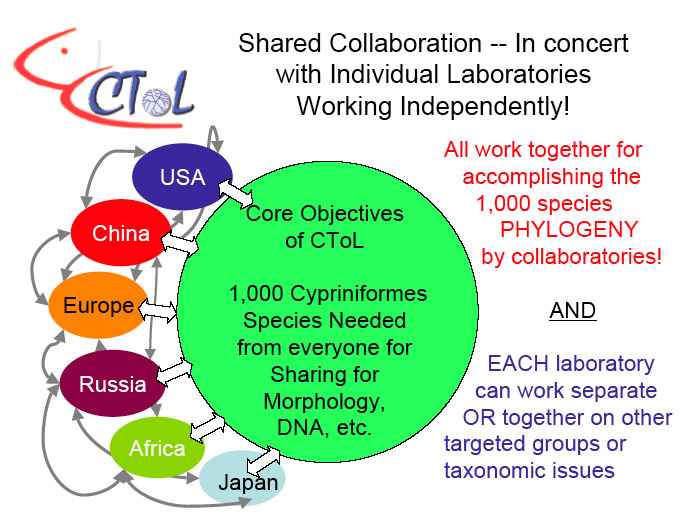
|
General Objectives
|
| Cypriniform Diversity |
| Outreach and Educaction |
| Portal |
General Objectives
The CToL project has a series of research goals and a diverse list of objectives to be achieved between 2004 and 2009. We expect to generate an array of nuclear and mitochondrial sequences as well as a diverse suite of internal and external morphological characters for a targeted group of 1,000 species. While this is a large number of species at first sight, it is less than 1/3 of the currently recognized diversity and only about 20% of our predicted diversity. We estimate that while roughly 3,200 species are currently recognized the final number of species in this order will exceed 5,000. Thus, the basic initiative of CToL is to survey a diverse array of representative species, genera, tribes, subfamilies, and families of Cypriniformes to establish a well-supported generalized phylogeny of the group. This phlylogenetic background based on multiple types of heavily scrutinized data will serve as a fundamental framework for this team of researchers and others around the world to complete a phylogeny of all species.
Members of CToL freely contribute sequences, morphological data, and specimens to this initiative without compromising their own individual research efforts on Cypriniformes. For example, notice in Figure 1 that everyone is working on the targeted 1,000 species, yet they are individually working on separate projects by themselves or in collaboration with other CToL member or other researchers. This structuring allows researchers to continue with their own project or laboratory initiatives and at the same time aid in moving the CToL objectives forward.

Many of the CToL members have also joined to advance other particular initiatives with Cypriniformes that are also open to other participants if they can and are willing to contribute in a significant way. If you are interested in joining one of these projects and have something to contribute please review our list of General Projects that you can join.
Major Research Questions with the CToL
- Are the major cypriniform clades monophyletic? There are few characters that support the major groups in the Cypriniformes. In particular, the large family Cyprinidae, containing most cypriniform diversity, has few characters supporting its monophyly?
- How do characters of phylogenetic significance develop from protein-gene interactions to fully formed adult morphology?
- Are there constraints imposed on morphology that generate homoplastic convergence which inaccurately reflect underlying relationships?
- How does polyploidy impact morphological diversity?
- What is the age of cypriniformes and major groups within this clade?
- What is the relationship between the phylogenetic history of this ancient lineage and known Earth history?
Major Objectives
- Develop an interactive Web Portal for synergistic research and educational activities on Cypriniformes (online keys; identification methods for otoliths – bony inner ear elements often found in archeological sites), education on diversity and distributions, cultural history of Cypriniformes, impacts of invasive species, and links to other sites like FishNet, Tree of Life, FishBase, etc.
- Reconstruct relationships of ca. 350 genera and species using entire mitochondrial sequences, nDNA, and a suite of morphological characters.
- Reconstruct relationships of 1,000 species using three mitochondrial genes and four nuclear genes and a suite of morphological characters.
- Examine development of 30 species, representing major clades, providing an essential framework for evolutionary, developmental, and “systems” biology questions in ongoing research programs involving zebrafish, Danio rerio (in coordination with Zfin organization).
- Conduct inventories and rapid bio-assessments of remote aquatic ecosystems containing cypriniform species in coordination with the All Catfish Species Inventory project.
- Describe species and produce classifications.
- Examine historical biogeography of cypriniform fishes from global to regional scales using recent and fossil taxa and their hypothesized relationships.
- Test hypotheses of molecular/morphological evolution by incorporating fossils and tectonic history of Earth.
- Provide online database for distributional studies, in collaboration with FishNet containing vital information on the changing distributions and impacts of invasive cypriniform species.
- Provide public information on diversity of cypriniform fishes, in collaboration with FishBase, and their cultural and economic importance.
- Provide online keys to major groups and some species, especially commercially important and invasive species.
- Provide fundamental educational site on cultural importance, impacts of exotics, natural diversity, etc.
- Maintain the Tree of Life web pages for the Cypriniformes.
